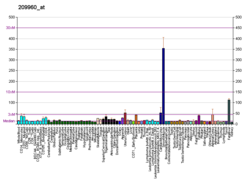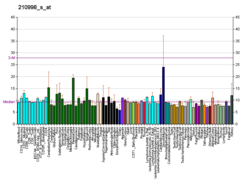Clinical significance
Human HGF plasmid DNA therapy of cardiomyocytes is being examined as a potential treatment for coronary artery disease as well as treatment for the damage that occurs to the heart after myocardial infarction. [10] [11] As well as the well-characterised effects of HGF on epithelial cells, endothelial cells and haemopoietic progenitor cells, HGF also regulates the chemotaxis of T cells into heart tissue. Binding of HGF by c-Met, expressed on T cells, causes the upregulation of c-Met, CXCR3, and CCR4 which in turn imbues them with the ability to migrate into heart tissue. [12] HGF also promotes angiogenesis in ischemia injury. [13] HGF may further play a role as an indicator for prognosis of chronicity for Chikungunya virus induced arthralgia. High HGF levels correlate with high rates of recovery. [14]
Excessive local expression of HGF in the breasts has been implicated in macromastia. [15] HGF is also importantly involved in normal mammary gland development. [16] [17]
HGF has been implicated in a variety of cancers, including of the lungs, pancreas, thyroid, colon, and breast. [18] [19] [20]
Increased expression of HGF has been associated with the enhanced and scarless wound healing capabilities of fibroblast cells isolated from the oral mucosa tissue. [21]
Circulating plasma levels
Plasma from patients with advanced heart failure presents increased levels of HGF, which correlates with a negative prognosis and a high risk of mortality. [22] [23] Circulating HGF has been also identified as a prognostic marker of severity in patients with hypertension. [24] Circulating HGF has been also suggested as a precocious biomarker for the acute phase of bowel inflammation. [25]
This page is based on this
Wikipedia article Text is available under the
CC BY-SA 4.0 license; additional terms may apply.
Images, videos and audio are available under their respective licenses.















